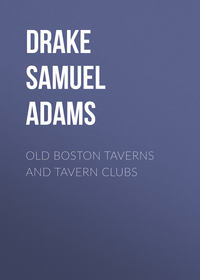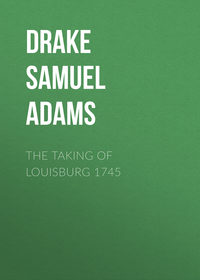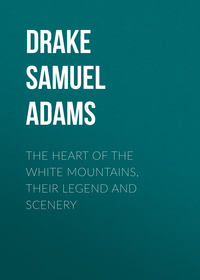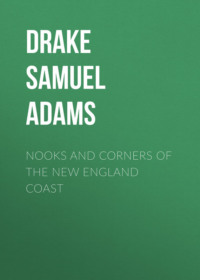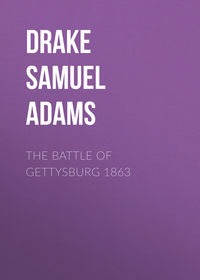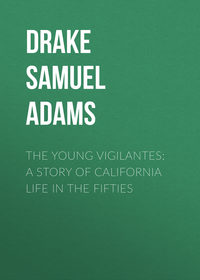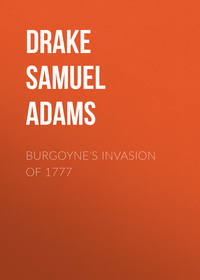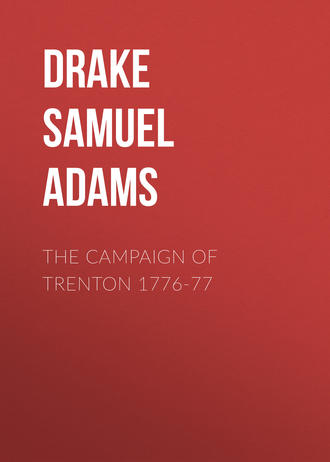 полная версия
полная версияThe Campaign of Trenton 1776-77
Howe was fully informed of what was going on by his royalist friends in the city, and like the cat watching the wounded mouse while it is recovering its breath, he prepared to spring at the moment his enfeebled adversary should show signs of returning animation.
British seize New York.
All being ready, on the very day fixed for the evacuation, Sir Henry Clinton crossed the East River in boats from Newtown Bay to Kipp's Bay, with 4,000 men, landed without opposition, owing to a disgraceful panic which seized the Americans posted there for just such an emergency, and thus thrust himself in between the Americans in the city and those at Harlem Heights. Thus cut off, it was only at the greatest risk of capture that the garrison below was saved, with the loss of much artillery, tents, baggage, and stores, by marching out on one road while the enemy were marching in on another,[1] as Clinton had immediately pushed on up the island, at the heels of the retreating Americans.
A captain of British grenadiers describes what took place after the landing, in the following animated style:
"After landing in York Island we drove the Americans into their works beyond the eighth milestone from New York, and thus got possession of the best half of the island. We took post opposite to them, placed our pickets, borrowed a sheep, killed, cooked, and ate some of it, and then went to sleep on a gate, which we took the liberty of throwing off its hinges, covering our feet with an American tent, for which we should have cut poles and pitched had it not been so dark. Give me such living as we enjoy at present, such a hut and such company, and I would not care three farthings if we stayed all the winter, for though the mornings and evenings are cold, yet the sun is so hot as to oblige me to put up a blanket as a screen."
Great fire, September 21.
Each side now rested in possession of half the island, Washington of all above Harlem Heights, Howe of all below. His conquest was, however, near proving a barren one, at best, for within a week a third part of the city was laid in ashes, some say by incendiaries, some by accident.
The situation was now so far reversed that Washington seemed to be blockading Howe in the city.
Captain Hale hanged.
Though it had little bearing upon the result of the campaign, one other event is deserving of brief mention here. Clinton's descent had been cleverly managed, out of Washington's sight. What were the enemy proposing to do next? It was imperative to know. To ascertain this Capt. Nathan Hale volunteered to go over to Long Island. At his returning he was arrested. The papers found upon him betrayed his purpose in going within the enemy's lines, and he was forthwith hanged in a manner that would have disgraced Tyburn itself.
Howe's next move was probably conceived with the twofold design, first of cooping Washington up within the island, and second of capturing or breaking up his entire army.
Howe's delays.
But again and again we are puzzled to account for Howe's delays. Hard fighter that he unquestionably was, he seemed never in a hurry to begin. There is even some ground for believing that in New York he had found his Capua. Be that as it may, it is certainly true that nearly a whole month passed by before the sluggard Sir William again drew sword.
Lands at Throg's Neck.
Leaving Lord Percy to defend the lines below Harlem with four brigades, at eight o'clock P.M. of the 11th of October, General Clinton with the reserves, light infantry and 1,500 Hessians, embarked on the East River, passed through Hell Gate, and landed at Throg's Neck,[2] in Westchester, early the next morning.

STORMING OF FORT WASHINGTON.
Explanation – E, American positions; A-C, British attacks by Harlem River; B, via King's Bridge; D, from Harlem Plains.
Washington moves to White Plains.
Here he lay inactive for six whole days, within six miles of the road on which Washington was moving out from King's Bridge to White Plains; for at the first notice given him of the enemy's movements, which indeed had all along been anxiously expected, Washington had been drawing out his forces from Harlem to King's Bridge, first sending forward some light troops to delay Howe as much as possible, until the army could get into position. It is evident that but for Howe's delays this purpose could not have been successfully accomplished.[3]
Howe marches to give battle.
Meantime the enemy had been bringing up reënforcements, and on the 18th, finding the mainland too strongly held at Throg's Neck, for an advance from that point, they made another landing six miles beyond, whence they marched toward New Rochelle. From here they again marched (22d) for White Plains, where Washington was found (27th) drawn up in order of battle behind the Bronx, waiting for them.
Battle of White Plains, October 28.
Here Washington attempted to make a stand, but his right[4] being vigorously attacked and turned, he was forced to fall back upon a second position, in which he remained unmolested for several days, when (November 1) he moved still farther back, to the heights of North Castle, where he felt himself quite safe from attack.
Howe had now manœuvred Washington out of all his defences except Fort Washington, which by General Greene's advice was to be defended, though now cut off from all support.
Fort Washington taken.
Things remained in this situation until November 16, when the fort was assaulted on three sides, with the result that the whole garrison of about 3,000 men were made prisoners of war.[5] At some points the resistance was obstinate, notably at the north, and again at the east, where one of the attacking divisions attempted to gain the rocky shore back of the Morris House, under Harlem Heights. A British officer,[6] there present, says of it that "before landing the fire of cannon and musketry was so heavy that the sailors quitted their oars and lay down in the bottom of the boats, and had not the soldiers taken the oars and pulled on shore we must have remained in this situation."
Effect on the army.
Washington and Lee.
The loss of the garrison of Fort Washington, 2,000 of whom were regular troops, was universally regarded as the most severe blow that the American cause had yet sustained, and it had a most depressing effect both in and out of the army, but more particularly in the army, as it tended to develop the growing antagonism between the commander-in-chief and General Lee, who had ineffectually advocated the evacuation of Fort Washington when the army was withdrawn from the island. Lee's military insight had now been most decisively vindicated. His antipathy to serving as second in command became more and more pronounced, and was more or less reflected by his admirers, of whom he now had more than ever. Worse still, it was destined soon to have the most deplorable results to the army, the cause, and even to Lee himself.
V
THE SITUATION REVIEWED
The new situation.
The dilemma now confronting Washington was hydra-headed. Either way it was serious. On one side New England lay open to the enemy, on the other New Jersey. And an advance was also threatened from the North. If he stayed where he was, the enemy would overrun New Jersey at will. Should he move his army into New Jersey, Howe could easily cut off its communications with New England, the chief resource for men and munitions. Of course this was not to be thought of. On the other hand, the conquest of New Jersey, with Philadelphia as the ultimate prize, in all probability would be Howe's next object. At the present moment there was nothing to prevent his marching to Philadelphia, arms at ease. To think of fighting in the open field was sheer folly. And there was not one fortified position between the Hudson and the Delaware where the enemy's triumphal march might be stayed.
Forced by these adverse circumstances to attempt much more than twice his present force would have encouraged the hope of doing successfully, Washington decided that he must place himself between the enemy and Philadelphia, and at the same time hold fast to his communications with New England and the upper Hudson. This could only be done by dividing his greatly weakened forces into two corps, one of which should attempt the difficult task of checking the enemy in the Jerseys, while the other held a strong position on the Hudson, until Howe's purposes should be more fully developed. With Washington it was no longer a choice of evils, but a stern obedience to imperative necessity.
The army divided.
Washington in New Jersey.
Lee was now put in command of the corps left to watch Howe's movement east of the Hudson, loosely estimated at 5,000 men, and ordered back behind the Croton. Heath, with 2,000 men of his division, was ordered to Peekskill, to guard the passes of the Highlands, these two corps being thus posted within supporting distance. With the other corps of 4,000 men Washington crossed into New Jersey, going into camp in the neighborhood of Fort Lee, where Greene's small force was united with his own command.[1] Orders were also despatched to Ticonderoga, to forward at once all troops to the main army that could be spared. Fort Lee had thus become the last rallying-point for the troops under Washington's immediate command, and in that sense, also, a menace to the full and free control of the lower Hudson, which the guns of the fort in part commanded at its narrowest point. Howe determined to brush away this last obstruction without delay.
Fort Lee taken.
Regarding Fort Lee as no longer serving any important purpose, perhaps foreseeing that it would soon be attacked, Washington was getting ready to evacuate it, when on the night of November 19[2] Lord Cornwallis made a sudden dash across to the New Jersey side, passing Fort Lee unperceived, landed a little above the fort at a place that had strangely been left unguarded, climbed the heights unmolested, and was only prevented from making prisoners of the whole garrison by its hurried retreat across the Hackensack. Everything in the fort, even to the kettles in which the men were cooking their breakfasts, was lost.
As regards any further attempt to stay the tide of defeat, all was now over. The enemy had obtained a secure foothold on the Jersey shore from which to march across the State, when and how he pleased. Unpalatable as the admission may be, the fact remains that the Americans had been everywhere out-generaled and out-fought. Nearly everything in the way of war material had been lost in the hurried evacuation of New York.[3] Confidence had been lost. Prestige had been lost. Clearly it was high time to turn over a new leaf. With this lame affair the first division of the disastrous campaign of 1776 properly closes, and the second properly begins. It had been watched with alternate hope, doubt, and despondency. Excuses are never wanting to bolster up failing reputations. The generals said they had no soldiers, the soldiers declared they had no generals; the people hung their heads and were silent.

AMERICAN POSITION BEHIND THE HACKENSACK.
VI
THE RETREAT THROUGH THE JERSEYS
It was now the 20th of November. In a few weeks more, at farthest, the season for active campaigning would be over. Thus far delay had been the only thing that the Americans had gained; but at what a cost! Yet Washington's last hopes were of necessity pinned to it, because the respite it promised was the only means of bringing another army into the field in season to renew the contest, if indeed it should be renewed at all.
Strength of the army.
State of public feeling.
Losses in battle, by sickness or desertion, or other causes, had brought his dismembered forces down to a total of 10,000 men, of whom 3,500 only were now under his immediate command, the rest being with Lee and Heath. And the work of disintegration was steadily going on. Always hopeful so long as there was even a straw to cling to, Washington seems to have expected that the people of New Jersey would have flown to arms, upon hearing that the invader had actually set foot upon the soil of their State. Vain hope! His appeal had fallen flat. The great and rich State of Pennsylvania was nearly, if not quite, as unresponsive. Disguise it as we may, the fire of '76 seemed all but extinct on its very earliest altars, and in its stead only a few sickly embers glowed here and there among its ashes. The futility of further resistance was being openly discussed, and submission seemed only one step farther off.
In one of his desponding moments Washington turned to his old comrade, Mercer, with the question, "What think you, if we should retreat to the back parts of Pennsylvania, would the Pennsylvanians support us?"
Though himself a Pennsylvanian by adoption, Mercer's answer was given with true soldierly frankness. "If the lower counties give up, the back counties will do the same," was his discouraging reply.
"We must then retire to Augusta County in Virginia," said Washington, with grave decision, "and if overpowered there, we must cross the Alleghanies."
A volume would fail to give half as good an idea of the critical condition of affairs as that brief dialogue.
Cruelties to prisoners.
First and foremost among the many causes of the army's disruption was its losses in prisoners. Not less than 5,000 men were at that moment dying by slow torture in the foul prisons or pestilential floating dungeons of New York. Turn from it as we may, there is no escaping the conviction that if not done with the actual sanction of Sir William Howe, these atrocities were at least committed with his guilty knowledge.[1] The calculated barbarities practised upon these poor prisoners, with no other purpose than to make them desert their cause, or if that failed, totally to unfit them for serving it more, are almost too shocking for belief. It was such acts as these that wrung from the indignant Napier the terrible admission that "the annals of civilized warfare furnish nothing more inhuman towards captives of war than the prison ships of England."
This method of disposing of prisoners was none the less potent that it was in some sort murder. Washington had not the prisoners to exchange for them, Howe would not liberate them on parole, and when exchanges were finally effected, the men thus released were too much enfeebled by disease ever to carry a musket again.
In brief, more of Washington's men were languishing in captivity in New York than he now had with him in the Jerseys. And he was not losing nearly so many by bullets as by starvation.
Affects recruiting.
We have emphasized this dark feature of the contest solely for the purpose of showing its material influence upon it at this particular time. The knowledge of how they would be treated, should they fall into the enemy's hands, undoubtedly deterred many from enlisting. In a broader sense, it added a new and more aggravated complication to the general question as to how the war was to be carried on by the two belligerents, whether under the restraints of civilized warfare, or as a war to the knife.
Thrown back upon his own resources, Washington must now bitterly have repented leaving Lee in an independent command. If there was any secret foreboding on his part that Lee would play him false, we do not discover it either in his orders or his correspondence. If there was secret antipathy, Washington showed himself possessed of almost superhuman patience and self-restraint, for certainly if ever man's patience was tried Washington's was by the shuffling conduct of his lieutenant at this time; but if aversion there was on Washington's part he resolutely put it away from him in the interest of the common cause, feeling, no doubt, that Lee was a good soldier who might yet do good service, and caring little himself as to whom the honor might fall, so the true end was reached. It was a great mind lowering itself to the level of a little one. But Lee could only see in it a struggle for personal favor and preferment.
Retreat begins.
After the evacuation of Fort Lee, Lee was urged, unfortunately not ordered, to cross his force into the Jerseys, and so bring it into coöperation with the troops already there. The demonstrations then making in his front decided Washington to fall back behind the Passaic, which he did on the 22d, and on the same day marched down that river to Newark. On the 24th Cornwallis,[2] who now had assumed control of all operations in the Jerseys, was reënforced with two British brigades and a regiment of Highlanders.
Before this force Washington had no choice but to give way in proportion as Cornwallis advanced, until Lee should join him, when some chance of checking the enemy might be improved. At any rate, such a junction would undoubtedly have made Cornwallis more circumspect. As Lee still hung back, Washington saw this slender hope vanishing. He for a moment listened to the alternative of marching to Morristown, where the troops from the Northern army would sooner join him; but as this plan would leave the direct road to Philadelphia open, it neither suited Washington's temper nor his views, and he therefore adhered to his former one of fighting in retreat. And though he had failed to check Cornwallis at Newark he would endeavor to do so at New Brunswick.
For New Brunswick, therefore, the remains of the army marched, just as the enemy's rear-guard was entering Newark in hot pursuit. On finding himself so close to the Americans, Cornwallis pushed on after them with his light troops, but as Washington had broken down the bridge over the Raritan after passing it, the British were brought to a halt there.
New Brunswick evacuated.
Sustained by the vain hope of being reënforced here, either by Lee or by new levies of militia coming up as he fell back toward Philadelphia, Washington meditated making a stand at New Brunswick, which should at least show the exultant enemy that there was still some life left in his jaded battalions, and perhaps delay pursuit, which was all that could be hoped for with his small force. Instead, however, of the expected reënforcement, the departure of the New Jersey and Maryland brigades, still so called by courtesy alone, since they were but the shadows of what they had been, put this purpose out of the question. Again Washington reluctantly turned his back to his enemy.
Lee's troops were now the chief resource. What few militia joined the army one day melted away on the next. In Washington's opinion the crisis had come. He therefore wrote to his laggard lieutenant, "Hasten your march as much as possible or your arrival may be too late."
December 7.
Fortunately Cornwallis had orders not to advance beyond New Brunswick. He therefore halted there until he could receive new instructions, which caused a delay of six days before the pursuit was renewed.[3] On the 7th Cornwallis moved on to Princeton, arriving there on the same day that Washington left it. This was getting dangerously near, with a wide river to cross, at only one short march beyond.
In view of the actual state of things, this retreat must stand in history as a masterpiece of calculated temerity. Keeping only one day's march ahead of his enemy, Washington's rear-guard only moved off when the enemy's van came in sight. There is nowhere any hint of a disorderly retreat, or any serious infraction of discipline, or any deviation from the strict letter of obedience to orders, such as usually follows in the wake of a beaten and retreating army. Washington simply let himself be pushed along when he found resistance altogether hopeless. In this firm hold on his soldiers, at such an hour, we recognize the leader.
VII
LEE'S MARCH AND CAPTURE
December 2 and 3.
"Hasten your march or your arrival may be too late." When this urgent appeal was penned Lee had not yet seen fit to cross the Hudson, nor was it until Washington had reached Princeton that Lee's troops were at last put in motion toward the Delaware.
Hitherto Lee had been in some sort Washington's tutor, or at least military adviser, – a rôle for which, we are bound in common justice to say, Lee was not unfitted. But from the moment of separation he appears in the light of a rival and a critic, and not too friendly as either. In the beginning Washington had looked up to Lee. Lee now looked down upon Washington. Unquestionably the abler tactician of the two, Lee seemed to have looked forward to Washington's fall as certain, and to so have shaped his own course as to leave him master of the situation. In so doing he cannot be acquitted of disloyalty to the cause he served, if that course threatened to wreck the cause itself.
Lee's plans.
It is only just to add that for troops taking the field in the dead of winter, Lee's were hardly better prepared than those they were going to assist. General Heath, who saw them march off, says that some of them were as good soldiers as any in the service, but many were so destitute of shoes that the blood left on the rugged, frozen ground, in many places, marked the route they had taken; and he adds that a considerable number, totally unable to march, were left behind at Peekskill. This brings us face to face with the extraordinary and unlooked-for fact that instead of bending all his energies toward effecting a junction with the commander-in-chief, east of the Delaware, in time to be of service, Lee had decided to adopt an entirely different line of conduct, more in accord with his own ideas of how the remainder of the campaign should be conducted. Meantime, as a cloak to his intentions, he kept up a show of obeying the spirit, if not the letter, of his instructions, leaving the impression, however, that he would take the responsibility of disregarding them if he saw fit. If he had written to Washington, "You have had your chance and failed; mine has now come," his words and acts would have been in exact harmony.[1]
December 7 and 8.
On the 7th Lee was at Pompton. This day an express was sent off to him by Heath informing him of the arrival of Greaton's, Bond's, and Porter's battalions from Albany. Lee replied from Chatham directing them to march to Morristown, where his own troops were then halted. The prospect of this reënforcement, which in all probability he had been expecting to intercept, may account both for the slowness of Lee's march, and for the closing sentence of his reply to Heath. Here it is: "I am in hopes to reconquer (if I may so express myself) the Jerseys. It was really in the hands of the enemy before my arrival."
Washington crosses the Delaware.
December 8.
In halting as he did Lee was deliberately forcing a crisis with Washington, who was all this time falling back upon his supplies, while the British, having to drag theirs after them, could only advance by spurts. Here was a rare opportunity for fighting in retreat being thrown away, as Washington conceived, by Lee's dilatoriness in reënforcing him. Reluctant to abandon his last chance of giving the enemy a check, Washington seems to have thought of doing so at Princeton (ignorant that this spot was so soon to be the field of more brilliant operations) as a means of gaining time for the removal of his baggage across the Delaware. It was probably with no other purpose that his advance, which had reached Trenton as early as the 3d, was marched back to Princeton, which Lord Sterling was still holding with the rear-guard as late as the 7th, when, as we have seen, Cornwallis made his forced march from Brunswick to Princeton, in such force as to put resistance out of the question. Here he halted for seventeen hours, thus giving Washington time to reach Trenton, get his 2,200 or 2,400 men across the Delaware, and draw them up on the other side, out of harm's reach, just as his baffled pursuers arrived on the opposite bank.
Cornwallis immediately began a search for the means of crossing in his turn.[2] Here, again, he was baffled by Washington's foresight, as every boat for seventy miles up and down the Delaware had been removed beyond his adversary's reach.
On the day of this catastrophe, which seemed, in the opinion not only of the victors, but of the vanquished, to have given the finishing stroke to the American Revolution, Lee's force, augmented by the junction of the troops marching down to join him, was the sole prop and stay of the cause in the Jerseys.




